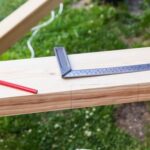Have you ever wondered: what does a jointer do in woodworking? Jointers are essential tools for creating smooth, flat surfaces on wooden boards. Whether you’re a beginner or an experienced woodworker, understanding the function and importance of a jointer is crucial for achieving professional-looking results in your woodworking projects.
A jointer is a woodworking machine used to create a flat surface along the length of a board, as well as to straighten one edge. This tool is invaluable for preparing wood for further processing, such as joining pieces together or creating uniform thickness throughout a workpiece.
In this article, we will explore the various types of jointers and their functions, the components of a jointer, and the significance of using this tool in woodworking. Additionally, we will provide a step-by-step guide on how to use a jointer properly, common mistakes to avoid when using one, tips for maintaining and caring for your jointer, and project ideas that require the use of this versatile tool.
Whether you’re working on small DIY projects or large-scale woodworking endeavors, understanding the role of a jointer is essential for achieving high-quality results.
Types of Jointers and Their Functions
When it comes to woodworking, jointers play a crucial role in achieving smooth, straight edges and surfaces on boards. There are several types of jointers available, each with its own unique functions and benefits. Here are some common types of jointers used in woodworking:
1. Benchtop Jointer: This type of jointer is compact and designed to be placed on top of a workbench. It is ideal for small woodworking projects and for hobbyists with limited space in their workshops.
2. Handheld Jointer: Also known as a power planer or hand planer, this type of jointer is portable and can be used to flatten and smooth the surface of boards. It is commonly used for on-site construction projects or for tasks that require mobility.
3. Long-bed Jointer: This type of jointer features an extended bed, allowing it to accommodate longer boards. It is ideal for professional woodworkers who often work with large pieces of lumber.
Each type of jointer serves a specific function based on the size of the workspace, the scale of the project, and the level of precision required.
Understanding the functionality and features of different jointers is essential in choosing the right tool for your woodworking needs. Regardless of the type, all jointers serve the same fundamental purpose – to create flat surfaces on lumber and ensure precise edges for seamless joinery in woodworking projects.
Understanding the Components of a Jointer
A jointer is an essential woodworking tool that is used to create a flat surface on a piece of wood, which is crucial for creating strong and seamless joints in woodworking projects. To understand the components of a jointer, it’s important to know how this tool works.
The main parts of a jointer include the infeed table, the outfeed table, the fence, and the cutter head with knives. When using a jointer, the infeed table is where you start by placing and flattening one face of your workpiece, while the outfeed table provides support as you guide your wood over the cutter head.
The fence on a jointer is used to keep your workpiece at 90 degrees to the tables, allowing you to create a flat edge on your wood. Some jointers also have adjustable fences that can be tilted for angle cutting. The cutter head with knives is responsible for cutting and smoothing the surface of your wood as it passes through the machine. It’s important to keep these knives sharp for optimal performance.
In addition to these main components, some jointers may also have safety features such as blade guards and push blocks to help prevent accidents during operation. Familiarizing yourself with each component and its function will help you effectively use a jointer in your woodworking projects without risk of injury or damage to your materials.
| Jointer Component | Function |
|---|---|
| Infeed Table | Flattens one face of workpiece |
| Outfeed Table | Provides support as workpiece passes through cutter head |
The Importance of Using a Jointer in Woodworking
A jointer is an essential tool in woodworking that is used to create a flat surface on the edge of a board. This is crucial for creating strong and seamless joints when joining pieces of wood together. The jointer essentially helps to straighten and flatten the edges of boards, allowing for better alignment and a more professional finish in woodworking projects.
There are various types of jointers available, each with its own specific functions. Some common types include benchtop jointers, hand-held jointers, and combination jointer-planers. Each type serves a different purpose, but all are designed to achieve the same goal – creating smooth and straight edges on boards for woodworking projects.
When using a jointer, it’s important to understand its components and how they work together to achieve the desired result. The infeed table, outfeed table, cutter head, fence, and guard are all integral parts of the jointer that play a role in producing flat surfaces on wood boards. Understanding how these components function will help you use the jointer effectively and safely.
- Infeed table: This is where the board enters the jointer
- Outfeed table: This is where the board exits after being processed by the cutter head
- Cutter head: Contains rotating blades that shave off small amounts of wood from the board
- Fence: Helps guide the board along a straight path while being processed
- Guard: Ensures safety by covering the spinning blades during operation
Knowing what each component does will give you greater control over your woodworking projects and ensure that your joints are precise and accurate.
Step-by-Step Guide on How to Use a Jointer
A jointer is a woodworking tool used to create a flat surface along the edge of a board. It is an essential tool for ensuring that boards fit together perfectly when creating furniture, cabinets, or other wooden projects. Understanding how to use a jointer is crucial for any woodworker, whether they are a beginner or an experienced craftsman.
To begin using a jointer, start by adjusting the infeed table to remove an appropriate amount of material from the edge of the board. The outfeed table should be parallel to the infeed table at the desired cutting depth. Once the tables are properly adjusted, turn on the jointer and push the board along the infeed table towards the cutter head. Apply firm and even pressure until the entire edge has been flattened.
After running both edges of your board through the jointer, you may notice some slight ridges or marks left by the cutting process. To remove these imperfections, you can lightly sand the edges by hand or with a power sander. This step will ensure that both edges are smooth and ready for further woodworking processes such as gluing or connecting with other boards.
| Step | Description |
|---|---|
| Adjust the infeed and outfeed tables | |
| Turn on the jointer and push board along infeed table | |
| Remove imperfections with light sanding |
Common Mistakes to Avoid When Using a Jointer
When using a jointer in woodworking, there are some common mistakes that you will want to avoid in order to achieve the best results. Understanding these mistakes and knowing how to prevent them can make a significant difference in the quality of your woodworking projects.
Improper Setup and Adjustment
One of the most common mistakes when using a jointer is not setting it up correctly or adjusting it properly. This can result in uneven cuts, tearout, and an overall sloppy finish. It’s important to carefully follow the manufacturer’s instructions for setting up the jointer and making sure that all components, such as the infeed and outfeed tables, fence, and cutter head, are aligned correctly.
Ignoring Safety Precautions
Another mistake to avoid is ignoring safety precautions when using a jointer. This powerful tool can be dangerous if not used properly, so it’s essential to wear appropriate safety gear such as goggles, ear protection, and push sticks. Additionally, never remove the guard or attempt to make adjustments while the jointer is still running.
Using Dull Blades
Using a jointer with dull blades is a common mistake that can result in poor cuts and potentially dangerous situations. It’s important to regularly inspect the blades for any signs of damage or dullness and sharpen or replace them as needed. Keeping sharp blades on your jointer will ensure clean and smooth cuts every time.
By being aware of these common mistakes and taking the necessary precautions, you can effectively use a jointer in woodworking projects to achieve professional results while maintaining safety at all times.
Tips for Maintaining and Caring for a Jointer
Maintaining and caring for a jointer is essential to ensure its longevity and performance in woodworking projects. Regular maintenance and proper care can help prevent wear and tear, prolong the life of the machine, and ensure accurate and precise results in woodworking.
One important tip for maintaining a jointer is to keep it clean after each use. Sawdust, wood shavings, and debris can accumulate on the blades, tables, and other components of the jointer, affecting its performance. Use a brush or vacuum to remove any residue from the machine to prevent buildup and maintain optimal functioning.
In addition to keeping the jointer clean, it’s crucial to regularly inspect and adjust the blades for sharpness. Dull blades can result in uneven cuts and rough surfaces on wood pieces. Sharpen or replace dull blades as necessary to ensure clean and smooth cutting action. Properly adjusting the blades will also contribute to better woodworking results.
Another important aspect of maintaining a jointer is lubrication. Apply lubricant to moving parts such as the cutter head, fence mechanisms, and adjustment knobs to reduce friction, minimize wear, and maintain smooth operation. Check manufacturer guidelines for recommended lubricants and schedule regular maintenance for oiling or greasing these components.
By following these tips for maintaining and caring for a jointer, woodworkers can ensure that their equipment remains in top condition for years to come. Regular cleaning, blade maintenance, and lubrication are key practices that contribute to the optimal performance of a jointer in woodworking projects.
Project Ideas That Require the Use of a Jointer
Creating Perfectly Flat Boards
One project idea that showcases the importance of a jointer in woodworking is creating perfectly flat boards. Whether you are working on a table, cabinet, or any other furniture piece, having flat boards is essential for a professional and polished finish. By using a jointer, you can ensure that your boards are smooth and even, allowing them to fit together seamlessly when assembled. This is especially important for projects that require precise measurements and seamless joints.
Making Wooden Panels
Another project idea that highlights what a jointer does in woodworking is making wooden panels. If you are constructing a door, drawer fronts, or decorative panels, having straight and flat boards is crucial. A jointer can be used to straighten the edges of the boards, allowing them to be glued together to create beautiful wooden panels. The use of a jointer ensures that the panels have clean and uniform edges, resulting in a professional-looking final product.
Building Woodworking Jigs
Woodworking jigs are essential tools for ensuring accuracy and consistency in various woodworking projects. Using a jointer to create straight and even edges on the necessary wood pieces for building jigs can significantly improve their performance and functionality. Whether you are making sleds, guides, or clamps, having accurately jointed pieces will contribute to the success of your jigs. Therefore, understanding what a jointer does in woodworking allows for the creation of high-quality jigs that enhance the overall woodworking experience.
These project ideas demonstrate the versatility and significance of jointers in woodworking projects. From creating flat boards to building intricate wooden panels and crafting reliable jigs, using a jointer is essential for achieving professional results in various woodworking endeavors.
Conclusion
In conclusion, it is evident that jointers play a crucial role in woodworking, allowing for the creation of smooth and even surfaces on wood pieces. The various types of jointers, from benchtop to hand-held models, offer a range of options for woodworkers to choose from based on their specific needs and projects. Understanding the components of a jointer, such as the beds, fence, and cutter head, is essential in order to maximize its functionality.
The significance of using a jointer in woodworking cannot be overstated. Not only does it ensure that wood pieces are properly aligned and fitted together, but it also contributes to the overall quality and precision of woodworking projects. By following a step-by-step guide on how to use a jointer and being aware of common mistakes to avoid, woodworkers can achieve the best results when working with this versatile tool.
Furthermore, proper maintenance and care for a jointer are imperative in order to prolong its lifespan and maintain its efficiency. Regular cleaning, sharpening of blades, and checking for any wear and tear are all essential aspects of caring for a jointer. Finally, with numerous project ideas that require the use of a jointer, it is clear that this tool opens up a world of creative possibilities for woodworkers looking to take their craft to the next level.
Frequently Asked Questions
What Is the Purpose of a Jointer?
The purpose of a jointer is to create a flat surface along the edge of a piece of wood. It is often used to prepare the edges of boards for joining together, creating smooth and straight edges for more seamless woodworking projects.
Do I Need a Jointer for Woodworking?
Whether or not you need a jointer for woodworking depends on the type of projects you are working on and your desired level of precision. If you frequently work with rough lumber and require perfectly flat, smooth edges, then a jointer would be a valuable tool in your workshop.
However, if your woodworking projects do not necessitate such precise edging, then other tools may suffice.
What Is Difference Between Jointer and Planer?
The main difference between a jointer and a planer lies in their respective functions. A jointer is used to create flat surfaces on the edges of boards, while a planer is used to create uniform thickness throughout the entire surface of the board.
In essence, the jointer prepares the edge for joining while the planer creates an even thickness across the entire board. Both tools serve different but complementary purposes in woodworking.

Hi everyone! I’m a woodworker and blogger, and this is my woodworking blog. In my blog, I share tips and tricks for woodworkers of all skill levels, as well as project ideas that you can try yourself.





